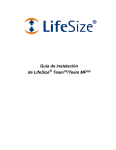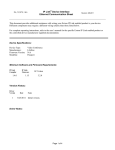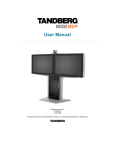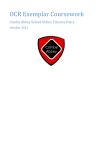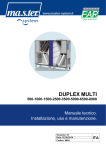Download "user manual"
Transcript
APPENDIX 12/01 TEST RESULTS FOR LIFESIZE TEAM 220™ Manufacturer: LifeSize Model: Team 220™ Software Version: 4.10.0 Optional Features and Modifications: None Date of Test: 5th – 9th March 2012 CODEC Front View CODEC Rear View Team 220™ 10x HD Camera CODEC with Vertical Stand LifeSize Phone™ Desk Microphone / Conference Phone Remote Control ii CO N T E N T S Page No. A: EXECUTIVE SUMMARY B: SETUP PROCEDURE ............................................1 ............................................................3 C: HARDWARE DESCRIPTION …................................................3 D: SYSTEM OPERATION .....................................................10 E: VIDEO TESTS ...................................................................15 F: AUDIO TESTS .................................................................16 G: DATA TESTS ..................................................................16 H: CONNECTIVITY ..................................................................16 Appendix 1 Detailed Physical Information .......................................18 Appendix 2 Detailed Video Tests ………….......................................20 Appendix 3 Detailed Audio Tests ………….......................................26 iii A: EXECUTIVE SUMMARY The IP capable high definition Lifesize Team 220™ conferencing system is designed to be installed either in a small to medium sized conference room or as part of a Rollabout system. The system includes a high definition (HD) Camera, microphone/s and infrared remote control. A four site continuous presence on-board Multipoint Conference Unit (MCU) is included as standard. The system is available with 2 camera and 2 microphone options: CODEC, Camera 200, Dual MicPods CODEC, Camera 10x, Dual MicPods CODEC, Camera 200, LifeSize Phone™ CODEC, Camera 10x, LifeSize Phone™ The 10x Camera has a 10x zoom lens and is more sensitive in low light conditions than the 200 with its 4x zoom. The systems supplied for evaluation included the 10x Cameras and the LifeSize Phone™ desk microphone/conference phones. The system is capable of conferencing up to a maximum picture resolution of 1920x1080 pixels (1080p) at 30fps or 1280x720 pixels (720p) at 60fps at a maximum connection speed of 6 Mbit/s. Compatibility with other H.323 CODECS is achieved across a range of resolutions from CIF (352x288) to 1920x1080 pixels, the quality of the conference being dependent upon the capability of the remote CODEC and the speed of connection. The default setting of 720p @ 60 frames per second was used for the majority of the evaluation. Pros: The sensitivity of the Camera 10x is improved over earlier LifeSize models Dual monitor as standard On-board 4 site continuous presence MCU as standard Good compatibility with other CODECS May be used in permanent installations or as a Rollabout Cons: Camera mechanical noise Cooling fan noise Restricted frame rate on Presentation channel 1 Feature Summary: Video standards Supported video resolutions Communications Audio standards Camera Video inputs Video outputs Audio inputs Audio outputs VC Auxiliary features H.261, H.263, H.263+ and H.264 QSIF (176x120) QCIF (176x144) SIF (352x240) CIF (352x288) 4SIF (704x480) 4CIF (704x576) 720p (1280x720) at 60 fps 1080p (1920x1080) at 30fps H.323 128Kbps - 6Mbps H.320 via optional LifeSize Networker G.711, G.722, G.722.1, G.728, G.729, Siren 14 and MPEG4 AAC-LC 16KHz audio coding 4x or 10x Optical zoom camera, PTZ function, 1080p native resolution, 10 camera presents, far end camera control, second 720p only camera may be added PTZ Camera input (1080p), second camera input (720p), VGA/DVI Input Dual monitor support VGA/DVI video output, HDMI output Lifesize Phone™, MicPod microphone, 2 x stereo line in, analogue telephone line. HDMI audio output, 3.5mm mini jack audio output H.239 second video channel up to 720p resolution in point to point and Multisite calls. Only the VGA input may be shared on the H.239 channel. Four site internal H.323 MCU supporting Continuous Presence only. Encryption Lifesize Phone™ desk microphone/speakerphone AES Encryption 2 B: SETUP PROCEDURE The camera (positioned adjacent to a picture monitor) and the CODEC have their own power supplies and together with the LifeSize Phone™ and infra red remote complete the package. Cabling the system was easy and involved: Connecting the supplied HDMI-HDMI and DVI-DVI leads between the CODEC and the high definition monitors. Connecting the HDMI cable between the CODEC and the camera. Cabling the Lifesize Phone™ to the CODEC. Establishing an Ethernet IP network connection through the single RJ45RJ45 cable. Connecting power to the CODEC and camera from their external power supplies. System set up was conveniently configured through the “on-screen” menus via the remote control. IP address, IP Gateway, Subnet mask and Gatekeeper (optional) address were all entered through these menus. Approximate set-up time: 20 Minutes Documentation quality: The documentation was concise and easy to follow and included: A printed Quick Reference card, with user manual and software release notes on CD. The entire set up procedure was straightforward. C: HARDWARE DESCRIPTION General The compact 1U deep CODEC may be cabinet mounted horizontally under a picture monitor or vertically on the supplied stand, it cannot be rack mounted. The basic system is an IP only unit with a single 10/100 Mbit/s, auto switching, Ethernet connection, enabling single site connection speeds of up to 6 Mbit/s, or multi-site (MCU) connections with a total site bandwidth of 6 Mbit/s. The Ethernet port may be manually configured or set to auto negotiate. An optional LifeSize Networker™ IP/ISDN gateway will provide H.320 ISDN connectivity if required. This option was not tested during the evaluation. The CODEC supports over 200 video resolutions including: The basic CIF format resolution of 352x288 pixels wCIF at 400x244 w288p at 512x288 w432p at 768x432 w480p at 848x480 High definition (HD) w720p i.e. 1280x720 3 High definition (HD) w1080p i.e.1920x1080 The following display resolutions and maximum frame rates are supported: 1280 x 720p 1280 x 768p 1920 x 1080p 1920 x 1080i 60fps 60fps 30fps 60fps Monitors used during the tests did not support 1080p, 30 frames /second, so all 1080 images were viewed at a display resolution of 1080i, 60fps. The maximum transmitted resolution and frame rate are determined by the display resolution selection and the camera video setting. The default settings are 720p and motion. CODEC Display Resolution set to 720p Camera Video Motion Mode Connection Resolution Frame rate Bandwidth 128 Kbit/s 432 x 240 30 384 Kbit/s 736 x 416 60 768 Kbit/s 1024 x 576 60 1 Mbit/s 1232x 688 60 2 Mbit/s 1280x720 60 3 Mbit/s 1280x720 60 4 Mbit/s 1280x720 60 6 Mbit/s 1280x720 60 CODEC Display Resolution set to 1080i Camera Video Motion Mode Connection Resolution Frame rate Bandwidth 128 Kbit/s 432 x 240 30 384 Kbit/s 912 x 512 30 768 Kbit/s 1280 x 720 30 1 Mbit/s 1480 x 832 30 2 Mbit/s 1920 x 1080 30 3 Mbit/s 1920 x 1080 30 4 Mbit/s 1920 x 1080 30 6 Mbit/s 1920 x 1080 30 Sharpness Resolution Frame rate 1280 x 720 1280 x 720 1280 x 720 1280 x 720 1280 x 720 1280 x 720 1920 x 1080 1920 x 1080 3 15 30 30 60 60 30 30 Sharpness Resolution 1280 x 720 1920 x 1080 1920 x 1080 1920 x 1080 1920 x 1080 1920 x 1080 1920 x 1080 1920 x 1080 Frame rate 1 5 10 15 30 30 30 30 Single and dual picture monitors are supported together with HDMI and DVI-I high definition outputs. The HDMI connection includes the main audio output signal but additional analogue audio outputs are also provided. 4 The main video output includes on-screen menus and the soft key icons corresponding to the four colour-coded buttons on the remote control. Main Menu Both Picture in Picture (PIP) and Picture outside Picture (POP) display formats are offered which allows both near and far end images to be displayed simultaneously on a single picture monitor. Far Image Full Screen, Near Image Picture in Picture (PIP) with Menu Overlay 5 Side by Side Far and Near Images, Picture outside Picture (POP) In single monitor mode the “layout-button” on the remote control cycles between a number of screen display layouts. Picture in Picture (PIP) may be set to be On, Off or Auto; in Auto when a change in the picture is detected the PIP and on-screen menu are displayed for a user definable time and then both fade out - default fade time is 10 seconds. With the main camera only being transmitted there are 3 screen display layout options: Full screen far end image + PIP of near end image Full screen near end image + PIP of far end image Side by side near and far end images When an H.329 presentation image together with the main camera image are either transmitted or received seven screen display layout options are available: Large presentation image plus small near and far end images POP Large far end image plus small presentation and near end images POP Large near end image plus small presentation and far end images POP Presentation image full screen plus near and far end images as PIPs Far end image full screen plus presentation and near end images as PIPs Near end image full screen plus presentation and far end images as PIPs Presentation and far end images side by side POP and near end image as a PIP 6 Large Presentation Image, Small Far and Near Images POP Side by Side Presentation and Far Images, Near Image PIP In dual monitor mode if the second monitor has its display set to “Calls +Presentations”, the monitors display the following images: Not in a call In a call with no presentation material Main Monitor Near image + menu Far image + menu 7 Second Monitor Source connected to the DVI-I input Near Image In a call with Far image + Near image Presentation material presentation side by side material transmitted or received The LifeSize 10x HD camera features pan, tilt and zoom functions with a wide horizontal viewing angle of 70 degrees and connects to the CODEC through the standard 3 metre HDMI cable. As an option this cable may be extended up to a maximum of 10 metres. Ten camera pre-set positions may be recalled from the remote control. The camera menu includes a range of manual settings for exposure, white balance and anti-flicker. A second camera may be connected via the CODEC‟s fire-wire „type‟ input connector. Only 720p cameras are supported and these also require their own external power supply. The 10x camera is more sensitive than earlier LifeSize 1080p examples and produces good results at lower lighting levels. The operation of the camera Pan and Zoom controls however does generate a significant level of mechanical noise, the CODECs cooling fan also generates some noise. The auto focus was slow to respond on occasions particularly at wide zoom angles and either locked in or out of focus, a slight adjustment was then required to the pan, tilt or zoom functions to reinitiate auto focus and thus correct the errors. The CODEC supports both remote camera control and remote video source selection. A PC may be interfaced directly via the DVI-I/VGA connector on the rear of the CODEC. Although no supported resolutions or frame rates are specified, we observed successful connections at the following resolutions: VGA 800 x 600 1024 x 768 1280 x 720 1280 x 768 1280 x 800 1280 x 1024 DVI-I 800 x 600 1024 x 768 1280 x 720 1280 x 768 1280 x 800 1280 x 1024 1360 x 768 1680 x 1050 1920 x 1080 During an H.323 call a second unidirectional video channel (dual stream) is provided through the H.239 protocol. Thus video from the camera and a PC could be transmitted simultaneously. The bandwidth split between main and H.239 channels may be defined by the user. The MultiSite (MCU) offers up to four-site H.323 MCU conferences, the host 8 Lifesize Team 220™ system plus three other remote sites. The speed of each site connection is dependent upon the number of sites in the MCU conference and the overall connection bandwidth. Audio bridging (for telephone calls) is also provided into conferences by connecting a standard telephone line to the CODEC. Several audio formats are supported by the LifeSize system, including the ITU standard MPEG-4 AAC-LC, giving 16KHz analogue audio. The MicPod microphone includes a microphone mute button. In larger locations two MicPods may be connected by using a splitter cable. Alternatively the LifeSize Phone™ provides the conference microphone together with a fully featured conference telephone. A standard telephone line may be connected to the CODEC or it will operate as an SIP* phone. To provide basic system control, this phone includes a dial pad, volume control and a microphone mute button. *SIP-Session Initiation Protocol. An international standard for phoning over IP networks, SIP also transports video and instant messaging if required LifeSize Phone™ The LifeSize Phone™ incorporates 16 microphones in a circular microphone array with beam forming for high directivity. The unit can also radiate far end sound through its internal loudspeaker but the speakers on the picture monitor or an external audio system may be preferred for this task. Mini jack connectors allow for straightforward integration with standard PC audio via the auxiliary line inputs. A Kensington lock is provided on the rear of the CODEC for added security. 9 D: SYSTEM OPERATION The system may be controlled either locally from the remote control or from another location over the network. The system does not include an RS232 port for integration with a room control system. Calls may also be initiated and terminated from the LifeSize Phone™ desktop unit. The remote control includes four context sensitive colour coded buttons: triangle, square, circle and return, the function of each button is indicated by the on-screen menu bar. This indication is vital as the function of each button can change depending on how the system is used. On Screen Menu Bar indicating the Function of the Colour Coded Buttons LifeSize Remote Control 10 There are dedicated buttons for Call, Hang up, Microphone mute, Near/Far camera, Display layout, Volume, Zoom and Input select. Selecting Microphone mute cuts sound both from the microphone and the auxiliary audio input. The camera has 10 pre-set positions which are stored and recalled via the remote control. The system takes two minutes forty seconds to boot up from cold. When not in a call the system automatically reverts to screensaver mode after a user-definable period of 1, 10, 20, 30 minutes or never. Sleep mode may also be activated after 1, 10, 20 or 30 minutes, 1, 2, 3 or 4 hours of inactivity. An incoming call or pressing a remote control button will then return the system to active mode. The Statistics menu displays call status data including resolution, connection speed, compression protocols, packet loss and frame rate for the main video channel. Frame rate information is not available for the second H.239 channel. In wide screen mode, a 4 x 3 aspect ratio video image transmitted from a computer is displayed on a widescreen monitor with the familiar black bars on each side of the image. To minimise this effect the CODEC has a “Video Stretch” facility that stretches the image horizontally to fill the available wide screen display resulting in lateral distortion of the image. An H.239 connection is initiated by selecting “Presentation Start” through the remote control and the on-screen graphical interface. The main camera normally occupies one channel and another selected image source the second channel. The remote site then receives separate images for display on two monitors. During tests between Lifesize Team 220™ systems the second H.239 channel achieved a maximum resolution of 1280 x 720 pixels at around 15 frames per second (the system statistics do not report H.239 frame rate). The connection speed had to exceed 2 Mbit/s with bandwidth allocation set to 50:50 (camera: presentation material) to maximise the frame rate. Increasing the overall bandwidth to 4 or 6Mbit/s did not increase this frame rate above the estimated 15fps it did however improve the overall quality by reducing image artefacts. Where frame rate is critical on presentation material consideration should be given to transmitting it on the main channel which will deliver 30 fps. Controlling an MCU conference is a simple procedure: 1. Select the “Call” button during a conference 2. Enter the number of the additional site into the call menu or select the site from the directory or the recent call list. 3. The additional site will then be connected to the conference. Individual calls or all connections may be disconnected using the graphic interface. 11 The MCU operates in continuous presence mode only and at the Team 220 provides a number of screen layouts in Single monitor mode: Traditional quad split of the four sites Full screen of any site and PIP images of the other three Large image of the first remote site to connect and POP images of the other three. Four Sites Quad Split Full Screen Site with Multiple PIPs 12 Large Image of the First Connected Site When presentation material is displayed additional layouts are available Presentation Large with Four Sites video POP images 13 Presentation with Remote Sites Quad Split, Local Site PIP Remote configuration and control is available via a web browser, with password protection, a useful tool for configuring the system and remote monitoring of calls. Call status, diagnostic information, and web snapshots of input and output images together with the ability to initiate and terminate calls are available through the web interface. A fully functional web version of the remote control is also available. Remote Configuration Screen Shot Screenshot reproduced by permission of LifeSize 14 Remote Web Snapshots with Statistics Screenshot reproduced by permission of LifeSize E: VIDEO TESTS SUMMARY The overall video quality of conference images was good but we preferred the appearance of the default 720p 60 fps images to the higher resolution ones at 1080p 30 fps. The quality of standard videoconference type material at 2Mbit/s and above was also good but fast moving movie trailer material transmitted on the main channel even at 6Mbit/s did appear slightly jerky. The auto focus was slow to respond on occasions particularly at wide zoom angles and either locked in or out of focus, a slight adjustment was then required to the pan, tilt or zoom functions to reinitiate auto focus and thus correct the errors. The restriction of presentation channel frame rate to ~15 frames per second even at the highest connection bandwidth may require that motion sensitive presentation video has to be transmitted on the main channel. 15 F: AUDIO TESTS SUMMARY Setup The echo canceller is fully automatic in operation. The quality of echo cancellation and doubletalk was very good. Audio levels adequate? (Yes/No) Audio quality acceptable? (Yes/No) Echo cancellation acceptable? (Yes/No) Quality of double talk G: Lecture Theatre Not tested Not tested Not tested Room Y Y Y Not tested Very Good DATA TESTS A PC may be directly connected to the CODEC via the DVI-I/ VGA interface. H: CONNECTIVITY Connectivity between Like Machines H.323 There were no problems connecting between the LifeSize Team 220™ units. During an H.323 call the network connection was removed and reconnected after a specific time. 5 Seconds 15 Seconds 20 Seconds secondss 30 Seconds Picture froze - successful reconnection, call does not terminate Picture froze - successful reconnection, call does not terminate Picture froze - successful reconnection, call then terminates after 3-4 seconds Picture froze - successful reconnection, call then terminates after 3-4 seconds Time to Connect H.323 10 Seconds Connectivity with Other Machines (models listed with comments) H.323 Successful connections were made in each direction with the following CODECs at the maximum bandwidth possible, where the system supported H.239 presentation material was also shared. 16 CODEC Model and Software Version Polycom® VSX7000 S/W 9.0.5.1 Tandberg Edge 95* S/W F9.0 PAL Tandberg 6000 MXP* S/W F9.0 PAL Tandberg C40 S/W TC4.2.1 Tandberg C60 S/W TC4.2.1 Tandberg C90 S/W TC4.2.1 Polycom HDX 9002 S/W 2.6.0 Lifesize Room 200 S/W 4.7.10 Lifesize Team S/W 4.7.19 Call Bandwidth 2 Mbit/s Resolution Transmitted by the Team 220 352 x 288 Resolution Received by the Team 220 352 x 288 2 Mbit/s 352 x 288 352 x 288 4 Mbit/s 880 x 496 720p 6 Mbit/s 720p 720p 6 Mbit/s 720p 720p 6 Mbit/s 720p 720p 2 Mbit/s 720p 720p 6 Mbit/s 720p 720p 4 Mbit/s 720p 720p *In connections with Tandberg Edge 95 and 6000 MXP systems lower resolutions than the maximum capability of both systems were negotiated Resolution in pixels and their common designation: 1920 x 1080 1280 x 720 1024 x 576 704 x 576 576 x 448 512 x 288 352 x 288 352 x 240 320 x 240 1080p 720p w4CIF 4CIF 448p wCIF CIF SIF QVGA Connectivity with JANET Videoconferencing Switching Service (JVCSS) H.323 The Lifesize Team 220™ connected successfully to the JVCS Codian MCU at high definition using H.264 video, 720p resolution and AAC-LC audio with video and audio in both directions. H.239 also interoperated correctly. The received audio level was measured as peaking to -4dBm. 17 Procedure for making a call 1. 2. 3. 4. Press Call button on the remote control Select connection speed/quality (the system defaults to auto) Input IP address or E.164 number Press the OK button Or use the Local Contacts directory available from the user interface. A recent call lists is also available. Appendix 1 Detailed Physical Information Dimensions: (w x h x d) 37 x 4.8 x 22 cm Video Inputs Main HD camera Second HD camera PC Video Outputs Main monitor Dual monitor Type Connector Digital Digital Digital/Analog RGB HDMI Firewire DVI-I Type Digital Digital Connector HDMI* DVI-I * The Main Monitor HDMI* output includes embedded audio. Audio Inputs Desk microphone / Speakerphone External microphone input with echo canceller Auxiliary stereo left Auxiliary stereo right Audio Outputs Main audio left and right Main audio left and right Level Line Connector RJ45 Microphone mini jack Line Line mini jack mini jack Level Digital Line Connector HDMI Mini jack Data 1. 1 off LAN 10/100 Mbits/s Ethernet connection (RJ45) 2. 1 off Networker ISDN Gateway connection (RJ45) 3. 1 off USB slot (future use) 4. 1 off RJ11 analogue telephone line input 5. 1 off RJ45 LifeSize Phone™ microphone/conference phone 18 Cables Supplied 1. 1 off 3 metre, HDMI-HDMI camera cable 2. 1 off 3 metre, HDMI-HDMI monitor cable 3. 1 off 3 metre, DVI-I-DVI-I monitor cable 4. 1 off 3 metre, 15 pin HD D Type male – DVI-I PC input cable 5. 1 off 10 metre RJ45-RJ45 Lifesize Phone™ cable 6. 1 off 3 metre RJ45-RJ45 network cable 7. 1 off 3 metre, RJ11-RJ11 telephone line cable 8. 2 off IEC power cord Mobility The LifeSize Team 220™ system is portable, lightweight and can be moved easily. To establish a connection each new location will need the local network information re-entered into the configuration menu. 19 Appendix 2 Detailed Video Tests Note: The LifeSize Team 220 system supports H.261, H.263, H.263+ and H.264 however it is not possible to select the video protocol in calls between LifeSize units. In the detailed video tests below only H.264, the default protocol selection between LifeSize units was tested. The systems supplied for evaluation did not share the same version of software Main system used for interoperability testing : 4.10.0 Second system used for detailed video tests : 4.8.3 We were unable to upgrade the second system to the latest software version. During the tests the video resolution varied with the connection speed: Connection Speed 384 Kbit/s 768 Kbit/s 2 Mbit/s 4 Mbit/s 6 Mbit/s Resolution 736 x416 1024 x576 1280 x720 1280 x720 1280 x720 For all the following tests at 384 Kbit/s the corresponding audio standard was Siren 14 and for all connection speeds > 384 Kbit/s was 16KHz AAC-LC. Objective Video Tests: Signal measurements 1. 75% EBU bars 2. Grey scale Subjective Video Impairments Tested: Lip synchronisation Block distortion (tiling) Blurring (reduced edge sharpness and spatial detail) Colour errors Jerkiness (distortion of smooth motion) Object persistence (lagging images from previous frames as faded or outline images) Scene cut response (i.e. time to build up the new image) Scale of impairments: Imperceptible Perceptible Slightly annoying Annoying Very annoying 1 2 3 4 5 20 LS BLK BLR CLR JRK OP SCR MII Test Tape: Signals recorded 1. EBU colour bars 2. Grey scale 3. Blue field 4. Medium close up female face, still 5. Medium close up female face, talking 6. Close up face, nodding 7. Close up face, shaking head side to side 8. Zoom out slowly to wide angle three people 9. Zoom in quickly to close up of centre person 10.Turntable speeds: 1,2,3 and 4 11.Football sequence 12.Zoom in and out of “A to Z” map 13.Text legibility, font sizes 20 to 12 pt 14.Cut tests, scenes various with camera movements 15.Man teaching at whiteboard (Insert 75% EBU bars at local site, measure at remote site) Time on tape 1min 30secs 1.40 - 2.40 2.50 - 3.50 4.00 - 5.00 5.10 - 6.10 6.20 - 7.20 7.30 - 8.30 8.40 - 9.40 9.50 - 10.50 11.00 - 15.30 15.40 - 16.40 16.50 - 17.50 20.30 - 20.50 21.00 - 22.00 22.10 - 23.23 Test 1c (H264): Colour bar test Subjective Impairments H.323 BLK BLR CLR 384 kbit/s 1 1 1 768 kbit/s 1 1 1 2 Mbit/s 1 1 1 4 Mbit/s 1 1 1 6 Mbit/s 1 1 1 768 kbit/s 1 1 1 2 Mbit/s 1 1 1 4 Mbit/s 1 1 1 6 Mbit/s 1 1 1 2 Mbit/s 1 1 4 Mbit/s 1 1 6 Mbit/s 1 1 Test 2c (H.264): Grey scale Subjective Impairments H.323 BLK BLR CLR 384 kbit/s 1 1 1 Test 3c (H.264): Blue screen Any waveform aberrations? None Subjective Impairments H.323 BLK CLR 384 kbit/s 1 1 768 kbit/s 1 1 21 Test 4c (H.264): Medium close up female (still) Subjective Impairments H.323 BLK BLR CLR 384 kbit/s 1 2 1 768 kbit/s 1 2 1 2 Mbit/s 1 1 1 4 Mbit/s 1 1 1 6 Mbit/s 1 1 1 4 Mbit/s 1 1 1 1 1 6 Mbit/s 1 1 1 1 1 4 Mbit/s 1 1 1 1 6 Mbit/s 1 1 1 1 4 Mbit/s 1 1 1 1 6 Mbit/s 1 1 1 1 Test 5c (H.264): Medium close up female (talking) Subjective Impairments H.323 LS BLK BLR CLR JRK 384 kbit/s 2 3 2 1 1 768 kbit/s 1 2 1 1 1 2 Mbit/s 1 1 1 1 1 Test 6c (H.264): Close up head (nodding) Subjective Impairments H.323 BLK BLR CLR JRK 384 kbit/s 3 2 1 1 768 kbit/s 2 1 1 1 2 Mbit/s 1 1 1 1 Test 7c (H.264): Close up head (shaking side to side) Subjective Impairments H.323 BLK BLR CLR JRK 384 kbit/s 4 3 1 1 768 kbit/s 3 3 1 1 22 2 Mbit/s 2 2 1 1 Test 8c (H.264): Medium close up, slow zoom out to three shot Subjective Impairments H.323 BLK BLR CLR JRK 384 kbit/s 2 2 1 1 768 kbit/s 2 1 1 1 2 Mbit/s 1 1 1 1 4 Mbit/s 1 1 1 1 6 Mbit/s 1 1 1 1 Test 9c (H.264): Three shot, quick zoom in to medium close up centre person Subjective Impairments H.323 BLK BLR CLR JRK 384 kbit/s 2 2 1 1 768 kbit/s 2 1 1 1 2 Mbit/s 1 1 1 1 4 Mbit/s 1 1 1 1 6 Mbit/s 1 1 1 1 2 Mbit/s 1 1 1 1 4 Mbit/s 1 1 1 1 6 Mbit/s 1 1 1 1 2 Mbit/s 1 1 1 1 4 Mbit/s 1 1 1 1 6 Mbit/s 1 1 1 1 Test 10c (H.264): Turntable speed 1 Subjective Impairments H.323 BLK BLR CLR JRK 384 kbit/s 2 1 1 1 768 kbit/s 1 1 1 1 Test 10f (H.264): Turntable speed 2 Subjective Impairments H.323 BLK BLR CLR JRK 384 kbit/s 2 1 1 1 768 kbit/s 1 1 1 1 23 Test 10i (H.264): Turntable speed 3 Subjective Impairments H.323 BLK BLR CLR JRK 384 kbit/s 2 2 1 2 768 kbit/s 1 2 1 2 2 Mbit/s 1 2 1 2 4 Mbit/s 1 2 1 2 6 Mbit/s 1 2 1 1 2 Mbit/s 1 3 1 2 4 Mbit/s 1 2 1 2 6 Mbit/s 1 2 1 1 2 Mbit/s 2 2 2 1 4 Mbit/s 2 2 2 1 6 Mbit/s 1 2 2 1 Test 10l (H.264): Turntable speed 4 Subjective Impairments H.323 BLK BLR CLR JRK 384 kbit/s 3 3 2 2 768 kbit/s 1 3 2 2 Test 11c (H.264): Football sequence Subjective Impairments H.323 BLK BLR CLR JRK 384 kbit/s 4 3 2 1 768 kbit/s 3 3 2 1 Test 12c (H.264): Zoom in and zoom out of „A to Z‟ map Subjective Impairments H.323 BLK BLR CLR JRK 384 kbit/s 4 4 1 2 768 kbit/s 3 3 1 2 24 2 Mbit/s 1 2 1 1 4 Mbit/s 1 2 1 1 6 Mbit/s 1 1 1 1 Test 13c (H.264): Text legibility (% of screen height) at viewing distance approx. 5x screen diagonal Legibility H.323 20 pt (3.5%) 16 pt (3%) 14 pt (2.5%) 12 pt (2.3%) 384 kbit/s Yes Yes Yes No 768 kbit/s Yes Yes Yes No 2 Mbit/s Yes Yes Yes No 4 Mbit/s Yes Yes Yes Yes 6 Mbit/s Yes Yes Yes Yes 4 Mbit/s 2 1 1 1 1 2 6 Mbit/s 2 1 1 1 1 2 4 Mbit/s 1 2 1 1 1 6 Mbit/s 1 1 1 1 1 Test 14c (H.264): Video with several vision cuts Subjective Impairments H.323 BLK BLR CLR OP SCR JRK 384 kbit/s 4 3 1 1 3 2 768 kbit/s 3 2 1 1 2 2 2 Mbit/s 2 2 1 1 2 2 Test 15c (H.264): Man teaching with flip chart Subjective Impairments H.323 LS BLK BLR CLR JRK Test 16: 384 kbit/s 2 2 2 1 1 768 kbit/s 1 2 1 1 1 2 Mbit/s 1 2 1 1 1 Playback from a domestic VHS videotape player. Is picture stable? As there is no analogue video input this test could not be carried out. 25 Appendix 3 Detailed Audio Tests Test 1: Frequency response (-3 dB) (Insert -6 dB signal at local site, measure at remote site) G.711 3.56 KHz G.722.1 7.05 KHz Siren 14 14.00 KHz G.722 7.10 KHz G.728 3.54 KHz G.729 3.54 KHz AAC-LC 16.00 KHz Test 2: Headroom (measured on AAC-LC connection) (Insert increasing amplitude 1 KHz tone at local site, monitor for overload distortion at remote site Aux output.) Overload occurs at: +10dBm Test 3: Audio level (Insert -6dBm 1KHz tone at local site, monitor received level at remote site auxiliary output) As the system audio output is adjusted by the on screen volume control an objective level measurement was not possible. Test 4: Echo Cancellation Setup The echo canceller is fully automatic in operation. The quality of echo cancellation and doubletalk was very good Audio levels adequate? (Yes/No) Audio quality acceptable? (Yes/No) Echo cancellation acceptable? (Yes/No) Quality of double talk 26 Lecture Theatre Not tested Not tested Not tested Room Y Y Y Not tested Very Good





























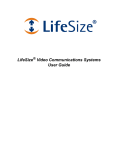
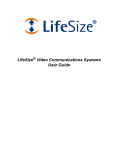


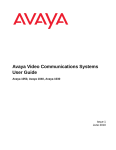
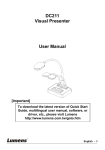
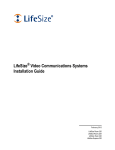
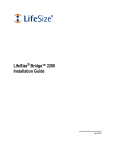
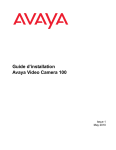
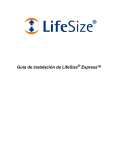
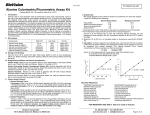
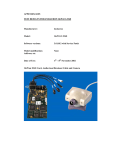

![キャンペーンリーフ[PDF形式/1.2MB]](http://vs1.manualzilla.com/store/data/006577664_2-ea9c13856fc67e9b0cf798bab316aeb7-150x150.png)
